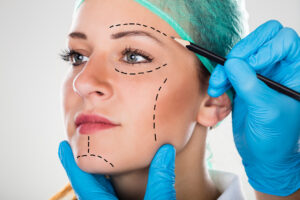
Injuries to the face can cause significant disabilities. For example, a nose injury can disrupt your breathing, and an injury to the orbital bones can impair your vision. These injuries can also cause significant disfigurement. Your face may swell, deform, or become asymmetrical as a result of damage to the bones or soft tissues of your face.
Facial injuries are also related to other injuries. A blow to the face can lead to nerve damage, a brain injury, or a dental fracture that further disables you and slows your recovery. Your facial injury might only represent a small segment of the medical problems you suffer from the trauma you experienced.
Table of Contents
What Is the Anatomy of Your Face?

Your head contains 22 bones. Your face contains a majority of these bones. You have 14 facial bones and eight cranial bones.
These bones give structure to your face. They also support the powerful muscles that allow you to chew and the delicate muscles that form your facial expressions. These muscles attach to the bones through tendons.
The nerves in your head, called the cranial nerves, run directly to your brain. Along with the nerves running to your vital organs, these are the only nerves that do not pass through the spinal cord.
The cranial nerves carry sensations from the face to the brain. These sensations include touch sensations from the nerve endings in the skin of your face. They also include visual sensations along the optic nerve, smell sensations along the olfactory nerve, and taste sensations along the seventh, ninth, and tenth cranial nerves.
The cranial nerves also carry motor signals from the brain to the face. These signals control the muscles and organs of the face. They cause your nose to sneeze, your salivary glands to drool, and your jaw muscles to chew.
Skin covers most of your external facial features. But unlike other parts of your body, your face has several exposed membranes, such as the membranes of your nose, eyes, and mouth. These membranes are often softer and more fragile than the skin.
What Are Common Causes of Facial Injuries?
Facial injuries can happen in many ways, including:
Burns
Burn injuries happen when a chemical reaction destroys your skin tissue. Depending on the type and severity of the burn, the reaction might also destroy the layer of fat and connective tissue under the skin. Burns can happen in many ways, including accidents involving flames, hot objects, or caustic chemicals.
Foreign Matter
Foreign debris can fly into your face. These shards can cause physical damage. For example, broken glass can fly into your face during a motorcycle accident, causing abrasions and lacerations.
Even if it does not penetrate your skin, it can get into your eyes, nose, and mouth. There, the foreign matter can poison or burn your membranes. For example, you could get sprayed with gasoline during a car accident that damages your nose and mouth and poisons your lungs.
Penetrating Wound
You suffer penetrating wounds when an object pierces your skin. These wounds can slice into the soft tissues of the face, including muscles, tendons, and ligaments. Sharp objects can also tear into blood vessels and nerves. In addition to the physical damage caused by the object, you can also bleed profusely, suffer an infection, and develop scars.
Blunt Trauma
Blunt trauma happens when your face impacts something without breaking the skin. Thus, your face suffers blunt trauma when it strikes the airbag during a car crash. Blunt trauma can break bones and cartilage. The jagged ends of a fractured bone can cause secondary injuries as it tears through your soft tissues.
What Are Some Examples of Facial Injuries?
Many different structures in your face can get injured during a traumatic event. Some examples of facial injuries include:
Facial Burns
Burns can come from many sources, including:
- Radiation
- Caustic chemicals
- Flames
- Hot objects, liquids, and gases
- Electric current
Minor first-degree burns can produce painful wounds but typically heal without any lasting damage. More severe second and third-degree facial burns can cause permanent scars and disfigurement. They can also result in nerve damage, leaving your face numb and paralyzed.
Fractured Jaw
A broken jaw is the second-most common facial fracture. Although most people only think about the lower mandible when they think about a broken jaw, you can also break your upper maxillary jaw. A jaw fracture can produce severe pain since you use your jaw to speak and chew. The swelling from a broken jaw can also interfere with your airway.
A broken jaw may require reconstructive surgery. During this surgery, the doctor will rebuild the jaw using plates and screws. Even when the jaw heals properly, you may suffer scars from the surgery and disfigurement from the tissues damaged by the broken bones.
Orbital Fracture
You have seven small bones that surround and support each eye. When these bones fracture, the eyeball can dislocate. As a result, you may suffer from blurry or double vision. Your face may look asymmetrical due to the displacement of your eye. You may also lose your vision due to damage the fractured bones cause to the eyeball and the muscles that move it.
Broken Nose
A broken nose is the most common form of facial fracture. The nose is a complex structure made of bone and cartilage. A broken nose can involve a fracture of either of these types of tissue.
In most situations, a broken nose heals without problems.
But in some cases, you may develop complications such as:
- Deviated septum
- Hematoma blocking the nostrils
- Disfigurement due to a crooked nose
In some cases, surgery can repair the functioning of your nose, and plastic surgery can repair its appearance.
What Are Some Co-Occurring Injuries?
Facial injuries often occur simultaneously with other injuries. Some co-occurring injuries include:
Concussion
A concussion happens when your brain shakes inside your skull. Facial trauma can cause your head to whip backward. This rapid and violent motion can cause minor damage to your brain as it rattles around. Concussion symptoms, such as headache, confusion, and clumsiness, usually clear up within two months of the injury.
Dental Fracture
A blow to the jaw can crack or even knock out your teeth. Dentists can sometimes replant a missing tooth. But the longer the tooth sits outside of the jaw, the harder it is to replant it successfully.
Nerve Damage
Nerve damage can severely affect your face. Severed nerves cause total paralysis and loss of sensations. A damaged nerve can cause weakness, pain, and muscle spasms. In either case, you could lose your ability to speak clearly and produce facial expressions. Unfortunately, doctors cannot repair damaged nerves. The resulting disabilities might last the rest of your life.
When Can I Get Compensation For a Facial Injury?
You can pursue personal injury compensation when your facial injury results from the intentional or negligent actions of others. Contact Shaked Law Personal Injury Lawyers for a free consultation to discuss the compensation you can seek for a facial injury.
